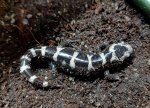I have three girls, two adults in together and a smaller one in on her own. Both enclosures are set up bio with a drainage layer and a lot of Pro Rep Forest Soil, numerous partially buried cork bark half tunnels, pieces of bark and driftwood pieces to burrow around - they seem to like doing this and a lot of their tunnel networks are around solid objects. They are covered with live moss and pincushion moss. Both tanks have small E. Hortensis in there (organic farmed) and I add one or two loaded crickets per animal if there is no live food in the tanks, they seem to disappear pretty quickly. Personally I don't like coco choir as it sticks to the animal and doesn't look as nice.
I have noticed the older they get the more reclusive they seem to be, when I originally got my first girl (as a juvenile) she took up permanent residence in one tunnel and would come out to eat, either crickets I dropped in front of her or ones fed from tongs. She was very bold and would walk to the front of the hide if she knew I was there. Now she will ignore food I offer and is content to stay in a burrow and hunt at night of her own accord. She is still a bit chubby so I have no worries, in fact I'm glad as she was leading a pretty sedentary lifestyle being served food right to her front door! The other adult female I got as an adult and is more secretive, she has a deep burrow underneath some moss and seems to stay there, when I go to bed (they are in my room) her head will be poking out of the moss waiting for bugs to walk past.
The juvenile girl I have (about 8-9cm head to tip of tail) wanders freely within minutes of the lights going off, she can be found roaming all over the enclosure and is sometimes out during the daytime. Don't see this one hunt or eat as much but she definitely seems bolder, I don't know if they become more secretive with age but my animals definitely seem to be like this. She has dug a small burrow which begins at a piece of wood and terminates underneath her favourite cork tunnel, she usually hides at either entrance.
So the brief summary is that as long as they have an environment they feel safe in, can have a dig if they want to (they are fossorial and I like natural behaviour) and are eating bugs then I wouldn't worry. They do have a reputation as reclusive animals which is true to an extent, a lot of people report going months without seeing them but when I go to bed a lot of the time I will see two heads poking out in one enclosure and one little roaming salamander in the other so YMMV. Sounds like yours has a good home so I wouldn't worry, finding out where their little tunnel networks are and how they have made a home for themselves in the habitat you provided makes them really rewarding IMO.

